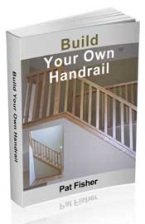Home
Woodworking
Hand Railings
Skirt Boards
Crown Molding
Bidding
Wainscoting
Chair Rail
Interior Doors
Closet Doors
Exterior Doors
Installing Doors
Baseboard
Installing Baseboard
Windows
Install Cabinets
Hand Tools
Power Tools
Blog
Contact
Link Partners
Tool Reviews
About Me
Can't Find Something?
Check The Sitemap
Site Map
Woodworking
Hand Railings
Skirt Boards
Crown Molding
Bidding
Wainscoting
Chair Rail
Interior Doors
Closet Doors
Exterior Doors
Installing Doors
Baseboard
Installing Baseboard
Windows
Install Cabinets
Hand Tools
Power Tools
Blog
Contact
Link Partners
Tool Reviews
About Me
Check The Sitemap
Site Map
[?] Subscribe To This Site
Handrail Parts
Handrail Parts for Wood StaircasesBuilding your own handrails may be a challenge, but when you understand the parts, it gets a little easier. We are going to look specifically at wood hand railing parts here as this site is about finish carpentry. There are several components involved here, so we will look at each one briefly. Then well take a look at the common wood species and styles available.
Straight, straight with plow and Bending handrail parts
These are the three most common types of handrails. Straight handrails are just that; a straight piece of hardwood species like red oak, cherry or African mahogany. This type of handrail sits on top of the balusters, or spindles, usually with a wood dowel or small fastener. These are available in a variety of sizes with many different profiles to suit your particular job.
All types of straight handrails are typically available in a plowed variety. The plowed area is cut into the bottom of the handrail that allows the spindles to be recessed into the handrail and filet is used between each spindle. Filet comes in lengths and is cut to fit between the spindles as the rail is being built. These are also available in those same hardwoods, hemlock and profiles mentioned above.
Bending handrail parts are available for circular or spiral staircases. These are constructed in such a way that allows them to be bent. Most times, the maximum these can be bent is a 4 foot radius. All handrail profiles can be made in a bending variety.
Balusters (spindles)
The balusters are those pretty little poles that run perpendicular to the handrail itself. I call these spindles, but the proper name is balusters. As handrail parts go, the balusters are probably the most important choice you will make when building that wood handrail. Balusters are purchased per piece and are responsible for the final look and feel of the staircase and handrail. Any hardwood is the choice here with red oak leading the way with hard maple, hickory and poplar as the more common choices. Pine is also available known as hemlock for all the parts of a railing.
Newel posts
At the top and bottom of the handrail are the newel posts. These mark the start and end of the staircase. The newel post can be of either a turned or box variety. Turned newel posts are more design centric and have been turned on a wood lathe. This is why they are called turned posts. Box newel posts are a square piece of hardwood that may be routed or otherwise decorated. Maple, oak and cherry varieties are among the most popular woods selected.
Wood species and Hand Railing Parts
Now when you go to buy handrail parts, you will be confronted with a plethora of woods. For handrails, hardwoods are the common choice. Among these are red oak, hard maple, African mahogany or Brazilian cherry, though there are others available as well. For the budget minded people there is a pine version also known as hemlock. All are suitable for a handrail application and can be purchased readily at home improvement centers everywhere.
Return From Handrail Parts to Home - Finishcarpentryhelp.com



